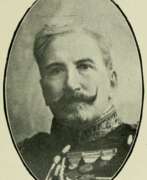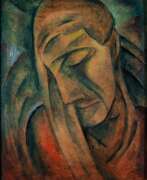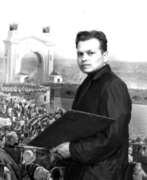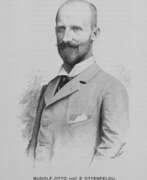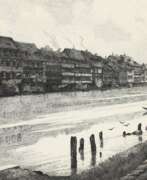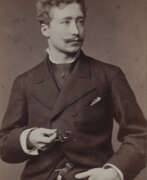Batalists 20th century


James Prinsep Beadle was an English painter of historical and military scenes.Beadle first exhibited at the Royal Academy in 1884 and also at the Paris Salon. Five years later, he was awarded a bronze medal at the Paris Exposition Universelle. Growing up in a military family, the artist was particularly attracted to military subjects.
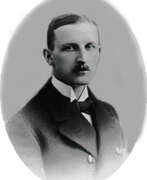

Claus Friedrich Bergen was a German painter of the first half of the twentieth century. He is known as a marine painter and illustrator.
Claus Bergen illustrated Karl May's adventure tales early in his career, creating more than 450 works. He specialized in nautical subjects, depictions of fishing and coastal landscapes, and traveled to Norway, England, the Mediterranean and America. During World War I, Bergen created paintings depicting sea battles; he was the only artist of his time to participate in a submarine raid. In World War II, he was included by the Nazis in the "God-given list" and his work was exhibited in Nazi exhibitions in Munich from 1937 to 1944.


Etienne Prosper Berne-Bellecour was a French artist. He was a painter, illustrator, and engraver who specialized in military scenes, battlefields, and portraits of soldiers. He is considered one of the most important French artists of the 19th century.
Berne-Bellecour began his career as an illustrator for French newspapers and magazines. He later became a painter, and in 1863 he exhibited his first painting at the Salon in Paris. In 1873, he became a member of the Académie des Beaux-Arts.
Berne-Bellecour was known for his highly detailed and realistic paintings of military life. He often depicted battle scenes with soldiers in uniform, and his attention to detail was highly admired. He was also known for his portraits of military leaders, including Napoleon III and Marshal MacMahon.
Berne-Bellecour continued to paint and exhibit his work throughout his life.
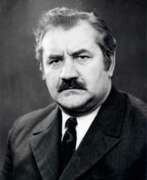

Nikolai Yakovlevich Bout (Russian: Николай Яковлевич Бут) was a Soviet artist of the second half of the twentieth century. He is known as a painter and graphic artist, a master of the battle genre.
Nikolai Bout began painting from his teenage years and immediately showed an interest in depicting historical battles. Throughout his career as a professional artist, he lived in Moscow, and spent the summer months in Kerch, where the subjects of many of his paintings originated. He painted portraits, battle and genre paintings, and landscapes. His works include the cycle "Adzhimushkay. 1942", series of paintings "Slovak National Uprising", "Heroic Marines" and other works.
Bout was an artist of the M. B. Grekov Studio of Military Artists since 1958.


Louis Braun was a German painter of the second half of the 19th and early 20th centuries. He is known as a painter and teacher and is considered one of the most famous German battle painters.
Louis Braun was a war painter for the Austrian army during the Austro-Prussian-Danish War in 1864, and he created several battle paintings commissioned by Emperor Franz Joseph I of Austria. He also accompanied Prussian troops during the Franco-Prussian War of 1870-1871, creating paintings on this theme. Brown's panoramic painting "Battle of Sedan" was a great success, for which the artist was awarded the title of professor at the Academy of Munich in 1902.
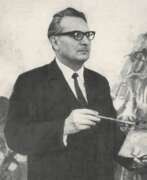

Alexander Gavrilovich Budnikov (Russian: Александр Гаврилович Будников) was a Soviet Ukrainian artist of the twentieth century. He is known as a battle painter.
During the Great Patriotic War Alexander Budnikov worked for a frontline newspaper, created posters and sketches from the battlefields. After the war he studied at the Kiev Art Institute, later became a teacher and professor at this institution. The artist worked in the genre of battle painting, and was also the author of a series of landscapes from different countries. His works are kept in museums in Ukraine, Russia and in private collections in Europe, the USA and Canada.


Thomas Calloway Lea III was an American muralist, illustrator, painter, war correspondent, writer and historian. Much of his fiction and literary work has focused on Texas, north-central Mexico, and his World War II experiences in the South Pacific and Asia. Two of his most popular novels, The Brave Bulls and The Wonderful Country, are considered classics of Southwestern American literature.


Michele Cammarano was an Italian realist painter. He is the author of numerous paintings in the battle genre. He studied painting at the Academy of Fine Arts in Naples.
In March 1870, during a trip to Paris, the artist met Gustave Courbet, whose work was close to his own views on art.


Adolf Iosifovich Charlemagne (Russian: Адольф Иосифович Шарлемань) was a renowned Russian painter, born in 1826 in Saint Petersburg. He excelled in historical, genre, and battle scenes, deeply influenced by his artistic lineage—his father was an architect and his grandfather a sculptor. Educated at the Imperial Academy of Arts under Fyodor Bruni and Bogdan Willewalde, Charlemagne's works are celebrated for their historical accuracy and intricate details.
Charlemagne's notable works include "The Capture of Kazan by Ivan the Terrible" and "The Battle of Kulikovo," which vividly capture significant moments in Russian history. His paintings are known for their meticulous attention to detail, dramatic compositions, and ability to convey the emotional intensity of historical events. These masterpieces are housed in prestigious Russian museums, showcasing his contributions to Russian cultural heritage.
Throughout his career, Charlemagne received numerous accolades, including the titles of Academician and Professor at the Imperial Academy of Arts. His dedication to historical accuracy and artistic excellence made him a prominent figure in Russian art.
For collectors and enthusiasts, owning a piece by Adolf Iosifovich Charlemagne means acquiring a significant part of Russian history. To stay updated on new product sales and auction events related to Charlemagne's works, sign up for our updates today.


Henri Georges Jacques Chartier was a French martial artist who painted on recent French military history. In 1902, Chartier received a bronze medal at the annual Salon of French Artists.
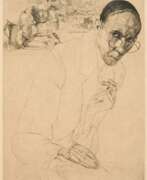

Jules De Bruycker, a Belgian graphic artist and etcher, is renowned for his depictions of Ghent, cathedrals, war scenes, and book illustrations. He achieved technical virtuosity in his prints and was considered one of Belgium's greatest etchers. His work showcased crowds and dramatic lighting, providing an intimate view of daily life in Ghent. De Bruycker's influences ranged from Flemish traditions to artists like Brueghel, Bosch, and Ensor. His later work included prints of cathedrals, figure studies, and sensuous nudes. De Bruycker's art greatly influenced his contemporaries, including Gustave van de Woestijne.


Jean-Baptiste Édouard Detaille was a French academic painter and military artist noted for his precision and realistic detail. He was regarded as the "semi-official artist of the French army". Detaille made his debut as an artist at the Salon—the official art exhibition of the Académie des Beaux-Arts—of 1867 with a painting of Meissonier's studio. At the Salon of 1868, he exhibited his first military painting, The Drummers Halt, which was based solely on his imagination of the French Revolution. Detaille enlisted in the 8th Mobile Bataillon of the French Army when the Franco-Prussian War broke out in 1870; by November he was seeing and experiencing the realities of war. This experience allowed him to produce his famed portraits of soldiers and historically accurate depictions of military manoeuvres, uniforms, and military life in general. He eventually became the official painter of the battles. He published a book called L'Armée Française in 1885, which contains over 300 line drawings and 20 color reproductions of his works.


Alexander Alekseevich Efimov (Russian: Александр Алексеевич Ефимов) was a Soviet artist of the mid-twentieth century. He is known as a battle painter, marinist and teacher.
Alexander Efimov participated in the Great Patriotic War and the main theme of his work was the history of the navy. He actively worked in the studio of marinists of the fleet, in his work he used the techniques of oil painting and watercolor. His works, including the paintings "Leningradki", "Sailors in the battles for Budapest", "Northern Fleet", became famous for their historical significance.
Efimov's works are in museums and private collections not only in Russia but also abroad.


Rudolf Rudolfovich Frentz (Russian: Рудо́льф Рудо́льфович Фре́нц) was a Soviet and Russian painter, watercolorist, graphic artist, and art teacher, known for his contributions to the Leningrad School of Painting. Born on July 23, 1888, in Marienburg, a suburb of Saint Petersburg, he studied at the Imperial Academy of Arts under Vasily Savinsky and Nikolai Samokish. Frentz's early work focused on battle scenes, which became a hallmark of his style.
Frentz's work is celebrated for its dynamic composition and attention to historical detail, particularly in his depictions of military scenes. He was a member of the Leningrad Union of Artists and was deeply involved in the artistic community of Leningrad. His paintings, which often portrayed the heroism and struggles of Soviet soldiers, were exhibited in numerous prestigious shows and galleries throughout his career.
Notable works by Frentz include paintings like "Battle of Borodino" and "Storming of the Winter Palace," which are admired for their dramatic intensity and historical accuracy. His legacy continues to be honored in Russian art history, with his works held in collections such as the State Russian Museum and the Tretyakov Gallery.
Stay updated on new product sales and auction events related to Rudolf Rudolfovich Frentz by signing up for our updates. This subscription will only notify you of relevant sales and events.


Conrad Freyberg was a German artist of the second half of the nineteenth and early twentieth centuries. He is known as a painter and sculptor.
Freyberg specialized in equestrian portraits and group portraits of horsemen, combining realistic likeness with delicate rendering. Inspired by the wars of 1866 and 1870-1871, the artist created battle paintings, including The Battle of Sadov and The Battle of Skalica. He later became a portrait painter and also worked in the genres of historical painting, animalistic painting and sports scenes. For his achievements, he received the title of court painter. The master was one of the creators of the bronze monument to Prince Albrecht of Prussia in Berlin's Charlottenburg district in 1901.
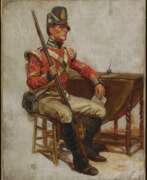

Emile Edwin Ganz is a Swiss-Belgian painter, specializing in the representation of horses and military scenes. In his early days, Ganz mainly drew military scenes, a genre that only a few 19th-century artists mastered. His masterpiece in the genre is The Attack of Scherpenheuvel, a report on the maneuvers of the grenadiers in 1894. In 1901 he entered the service of Princess Clémentine as a painter; he held this position until 1903. In 1903, he also brushed some of King Leopold II's horses. From that moment, he was no longer interested only in the horse itself, but in the regional draft horse, as well as in the people and the rural world: newspaper sellers, old horses in a depot, the harvest in the fields , beet harvest, landscape. Many of his designs for military uniforms were printed in color lithograph.


Boris Sergeevich Gennadyev (Russian: Борис Сергеевич Геннадиев) was a Russian painter. He graduated from the I.E. Repin Academy of Arts in the class of battle-painting. Later he became one of the representatives of the artistic movement of socialist realism.
Gennadyev created paintings dedicated to themes of Soviet life and history. He was also engaged in illustrating books and creating monumental and decorative compositions for public buildings.
He was drafted to the front during the Second World War, and died in 1942. His work can be found in museums and private collections in Russia.


Anatoly Andreevich Gorpenko (Russian: Анатолий Андреевич Горпенко) was a Soviet artist of the mid-twentieth century. He is known as a painter and graphic artist, battle painter and portraitist.
Anatoly Gorpenko served as a war artist during the Great Patriotic War, creating propaganda posters and front sketches. His oeuvre includes pictorial works, including battle scenes and portraits of military figures. He also participated in the creation of dioramas and panoramas, and his works, including stained glass windows and mosaics, decorated monuments and buildings, including in Berlin.
Gorpenko also did graphics for publishers and magazines and created political posters.


Nikolay Nikolaevich Karazin (Russian: Николай Николаевич Каразин) was a Russian military officer, painter, and writer, known for his depictions of wars and exotic places. Born in 1842 in Kharkov (now Ukraine), Karazin came from a family of prominent intellectuals, including his grandfather Vasily Karazin, who founded Kharkiv University.
Karazin's career began in the military, where he participated in campaigns against the January Uprising in Poland and in Central Asia. His firsthand experiences in battles, such as the 1868 Bukhara campaign and the 1873 Khiva campaign, greatly influenced his later work as a painter and writer. After retiring from the military, he focused on creating large canvases depicting military actions in Turkestan, as well as writing numerous adventure and ethnographic stories and novels.
Karazin's works, which include "In the Distant Confines" (1875) and "From Orenburg to Tashkent" (1886), reflect his deep engagement with the landscapes and cultures of Central Asia. His children's book "Cranes Flying South" remains popular for its vivid storytelling and illustrations. Karazin also contributed significantly to the visual arts, participating in early designs for the Moscow Metro and becoming an academician of the Imperial Academy of Arts in 1904.
To stay updated on new product sales and auction events related to Nikolay Karazin's works, sign up for our updates. This subscription will keep you informed about the latest opportunities to acquire pieces of his illustrious legacy.


Pavel Osipovich Kovalevsky (Russian: Павел Осипович Ковалевский) was a Russian painter renowned for his battle scenes and genre paintings. Born in Kazan in 1843, Kovalevsky studied at the Imperial Academy of Arts in St. Petersburg under the mentorship of B.P. Villevalde. His early work earned him multiple accolades, including gold medals for significant paintings such as "Persecution of Turkish Foragers by Cossacks" and "First Day of the Battle of Leipzig in 1813".
Kovalevsky’s artistic journey took him across Europe as an academic scholar, visiting cities like Munich, Vienna, Rome, and Paris. His experiences and observations during these travels significantly influenced his work. During the Russo-Turkish War of 1877–1878, he served as a war artist attached to the Russian Army, documenting the campaign under Grand Duke Vladimir Alexandrovich. His notable works from this period include "The Staff of the 12th Battalion in Bulgaria" and "Captured Turks," which are housed in the State Russian Museum.
In addition to his battlefield illustrations, Kovalevsky contributed to the education of future artists by leading the workshop for military painting at the St. Petersburg Academy of Arts from 1897 until his death in 1903. His legacy includes numerous works depicting historical and military scenes, which continue to be celebrated for their detailed representation and historical accuracy.
For collectors and enthusiasts, keeping abreast of new acquisitions and auction events featuring works by Pavel Osipovich Kovalevsky is essential. Sign up for updates to stay informed about the latest sales and exhibitions related to his art.


Lev Feliksovich Lagorio (Russian: Лев Феликсович Лагорио) was a Russian painter known for his exquisite seascapes and coastal landscapes. Born in 1827 in Feodosia, Crimea, Lagorio's Italian heritage and Russian upbringing greatly influenced his artistic style.
Lagorio's paintings are celebrated for their vibrant use of color and meticulous attention to detail, capturing the dynamic beauty of the sea and coastal environments. His works often depict serene seascapes, bustling ports, and dramatic coastal scenes, showcasing his ability to convey both tranquility and movement in nature. His technique involved capturing the subtle interplay of light and shadow, giving his paintings a lifelike quality.
Some of Lagorio's notable works include "View of the Caucasus Mountains from the Sea" and "Storm on the Black Sea," which are housed in prestigious institutions such as the State Russian Museum in St. Petersburg. Collectors and art enthusiasts highly value his contributions to maritime art.
For those interested in exploring the works of Lev Feliksovich Lagorio, signing up for updates on upcoming auctions and sales can provide exclusive access to new opportunities. Stay informed about the latest offerings by subscribing to our newsletter focused on Lagorio's masterpieces.


Felician Myrbach, an Austrian artist renowned for his multifaceted contributions to the art world, was a significant figure in the late 19th and early 20th centuries. Born in Zalesciki, Ukraine, in 1853, Myrbach's career spanned various roles, including painter, illustrator, and graphic artist. His educational journey included teaching at the cadet school in Vienna and studying at the Vienna Academy. In 1881, he moved to Paris to further his career as an illustrator, eventually becoming a professor of Illustration at the Vienna School of Arts and Crafts from 1899 to 1905.
Felician Myrbach's artistry was not confined to one location; he lived and worked in multiple European cities, including Paris, Barcelona, and near Bilbao, before passing away in Klagenfurt, Austria, in 1940. His works were displayed in prestigious exhibitions, such as the Vienna Secession shows and the Royal Watercolour Society in Belgium, showcasing his versatility and the broad appeal of his art.
Felician Myrbach's contributions to book illustration were notable, with his work appearing in various publications, such as Alphonse Daudet’s "Wives of Men of Genius" and "Trente ans de Paris à travers ma vie et mes livres." His distinctive signature can be found on many illustrations, underscoring his significant role in the art of book illustration during his time.
For collectors and experts in art and antiques, Felician Myrbach's works offer a glimpse into the vibrant art scene of his era, reflecting the cultural and artistic movements of the time. His legacy continues to be celebrated and studied, making him a pivotal figure in the history of European art.
For those interested in staying updated on Felician Myrbach, subscribing to updates can be a valuable way to stay informed about new product sales and auction events related to his work. This subscription service is dedicated to providing focused updates, ensuring that enthusiasts and collectors are well-informed about opportunities related to Myrbach's enduring legacy.


Victor Nehlig was a French-American painter. Born in Paris in 1830, Nehlig studied painting under Léon Cogniet and Abel de Pujol. In 1850, he moved to the United States, where he would live and work for the next 22 years, interrupted only by a brief stay in Havana, Cuba. During his time in the United States, Nehlig opened a studio in New York City and painted a variety of works in the academic style, often demonstrating his prowess at depicting the human figure. Nehlig returned to his native France in 1872, two years after being elected an academician in the National Academy of Design and shortly after his studio and many of his reference materials were destroyed in a devastating fire. While Nehlig was relatively well known among art enthusiasts during his time, his work has seen less attention in subsequent years.[3] He frequently painted interpretations of American history, taking a special interest in scenes from the American Civil War, the effects of which he witnessed firsthand.


Harold Septimus Power, usually known as H. Septimus Power or H. S. Power, was a New Zealand-born Australian artist, who was an official war artist for Australia in World War I. He exhibited in 1899 with the Melbourne Art Club and soon after moved to Adelaide where he worked as an illustrator and political cartoonist. In 1904, he was commissioned by the trustees of the Art Gallery of South Australia to paint an animal scene. He was a member of the Royal Institute of Oil Painters and the Society of Animal Painters. He also exhibited at the Royal Academy of Arts. After war broke out in the summer of 1914, the Australian government appointed official war artists to depict the activities of the Australian Imperial Force in the European theater of war. Power was appointed in 1917 and was attached to the 1st Division, A.I.F. from September to December of that year and then again in August the following year. Official War Artist during the First World War and was renowned for his depiction of animals, in particular horses, on the field of battle.


Carl Röchling was a German painter and illustrator known for his depictions of military and military-historical subjects. He gained fame for his portrayals of battle scenes, particularly those depicting Prussian army victories during the Franco-Prussian War.
Röchling collaborated with other artists such as Georg Koch and Eugen Bracht on projects like the panorama of the Battle of Chattanooga. He also worked alongside Richard Knötel and Woldemar Friedrich, illustrating popular children's books such as "Der Alte Fritz in 50 Bildern für Jung und Alt" (1895) and "Die Königin Luise in 50 Bildern für Jung und Alt" (1896).


Jan Bogumil Rosen (Russian: Ян Богумил Розен) was a Polish painter born on October 16, 1854, in Warsaw, and passed away on November 8, 1936, in the same city. He specialized in battle scenes and was known for his meticulous attention to detail, especially in depicting horses and military uniforms.
Rosen began his artistic education under the guidance of Franciszek Kostrzewski and later studied at the Academy of Fine Arts in Munich. He also trained under renowned painters Jean-Léon Gérôme and Isidore Pils at the Académie des Beaux-Arts in Paris. Throughout his career, Rosen's work was exhibited widely and garnered significant attention, particularly in Munich and Warsaw. One of his notable works, "Contest of Carriages at the Ujazów Castle Square," exemplifies his skill in portraying dynamic scenes with great precision.
In addition to his battle scenes, Rosen also produced genre paintings and portraits. His work received recognition from various prestigious institutions, and he served as a court painter for Tsar Alexander III of Russia. Despite spending much of his career abroad, Rosen's work remained deeply connected to Polish themes and history.
For collectors and enthusiasts interested in Jan Bogumił Rosen's works, subscribing to updates about new product sales and auction events is highly recommended. Stay informed about opportunities to acquire pieces by this masterful artist.


Franz Roubaud (Russian: Франц Алексеевич Рубо) was a Russian painter, known for his panoramic paintings and battle scenes. Born in Odessa in 1856, Roubaud studied at the Imperial Academy of Arts in St. Petersburg and furthered his education in Munich. His works are celebrated for their meticulous detail and dynamic composition.
One of his most famous works is the "Siege of Sevastopol," a monumental panorama depicting a key event from the Crimean War. This masterpiece is housed in the Panorama Museum in Sevastopol and stands as a testament to Roubaud's ability to convey historical grandeur and emotional intensity.
Roubaud's contributions to Russian art extend beyond his canvases, as he was also a respected professor at the Academy of Arts in St. Petersburg. His legacy continues to influence modern Russian painters, and his works are sought after by collectors and art enthusiasts worldwide.
Stay updated on new product sales and auction events related to Franz Roubaud (Rubo) by signing up for our newsletter. Don’t miss the chance to own a piece of history!


Hendrik Frans Schaefels or Henri François Schaefels, also known as Rik Schaefels was a Belgian Romantic painter, draughtsman and engraver known for his seascapes, cityscapes, genre paintings, landscapes with figures and history paintings. He worked in the Romantic style popular in Belgium in the mid nineteenth century and was highly esteemed in Europe for his representations of historic naval battles.


Wilhelm Schreuer was a German painter; associated with the Düsseldorfer Malerschule.
Most of his works were created with a distinctive technique, involving diluted colors on a damp surface, applied to glued paper; a method that makes major corrections almost impossible. The resulting surface is smooth as glass. Often, the effect is nearly monochromatic. Although he painted a wide variety of subjects, scenes from inns, restaurants, dance halls, and various events were obviously his favorites.


Christian Wilhelm Sell, also Christian Sell the Younger, was a German battle and military painter of the Düsseldorf School.
Like his father, Christian Sell the Elder, he created numerous battle and war depictions, especially from the Franco-Prussian War.


Richard Karl Sommer (Russian: Рихард-Карл Карлович Зоммер) was a Russian and Soviet artist of the late 19th and first third of the 20th centuries of German origin. He is known as a painter, graphic artist and watercolorist.
Sommer is most famous for his works created in Central Asia and Transcaucasia. He painted both domestic and battle scenes there, as well as landscapes of architectural monuments and old city neighborhoods. His paintings are characterized by clear composition and attention to detail, combining features of realism and impressionism, which made them popular among collectors and art connoisseurs.
The master was one of the founders of the Tiflis Society of Fine Arts.


Evgeny Alexandrovich Tikhmenev (Russian: Евгений Александрович Тихменев) was a Russian artist, born in 1869 and passed away in 1934. Renowned for his depictions of natural scenes and hunting expeditions, his works encapsulate the essence of rural Russian life during his time. Tikhmenev's artwork, such as "Before the Hunt," captures moments of anticipation and interaction with nature, often featuring meticulous detail and vibrant settings.
His pieces are cherished in art circles for their historical value and their ability to convey the story of an era when hunting was not only a sport but a significant aspect of rural survival and culture. Notably, Tikhmenev's paintings have been sold at various auctions, with some pieces fetching substantial prices, highlighting their desirability among collectors and art enthusiasts.
For collectors and experts in art and antiques, Tikhmenev's works present a valuable investment, both culturally and financially. To stay updated on new sales and auction events featuring Evgeny Alexandrovich Tikhmenev’s work, signing up for timely updates is recommended, ensuring enthusiasts don't miss out on acquiring a piece of Russian art history.


Mikhail Stepanovich Tkachenko (Russian: Михаил Степанович Ткаченко) was a late 19th- and early 20th-century Russian artist of Ukrainian descent. He is known as a painter and graphic artist who lived most of his career in France.
Mikhail Tkachenko worked as a landscape painter, marinist, and painted scenes of naval battles. For some time he was the first painter of the Main Naval Staff of the Russian Empire. Most of his works are in state collections in France, some are kept in the Central Naval Museum in St. Petersburg.
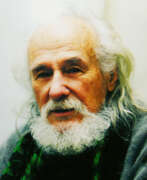

Victor Ivanovich Tolochko (Russian: Виктор Иванович Толочко) was a Soviet and Ukrainian artist of the second half of the twentieth and early twenty-first centuries. He is known as a painter, a decorated participant of the Great Patriotic War, a master of landscape, still life, battle and historical genres.
When working in the historical genre Victor Tolochko tried to live in the historical atmosphere. Working on the painting "Defenders of the Brest Fortress", he lived in the fortress for six months and created more than 50 sketches and sketches. In addition to the military theme, the master's life-affirming landscapes were also highly appreciated by critics.
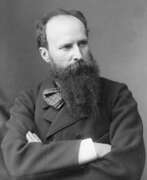

Vasily Vasilievich Vereshchagin (Russian: Васи́лий Васи́льевич Вереща́гин) was a Russian painter, known for his poignant and realistic depictions of war. He was born in 1842 in Cherepovets, Russia, and is celebrated for his dramatic and often controversial paintings that depicted the brutal realities of warfare.
Vereshchagin’s work stands out for its unflinching portrayal of the human cost of conflict. Unlike many of his contemporaries, he focused on the devastating consequences of war rather than glorifying it. His series of paintings from the Russo-Turkish War and his iconic piece, "The Apotheosis of War," are housed in prestigious institutions like the Tretyakov Gallery in Moscow and the Russian Museum in Saint Petersburg.
Collectors and art experts value Vereshchagin’s works for their historical significance and emotional depth. His paintings not only serve as powerful artistic statements but also as historical documents that provide insight into the wars of his time. For those interested in acquiring or learning more about Vereshchagin’s works, subscribing to updates about upcoming sales and auction events can be incredibly valuable.
Sign up to receive updates on new product sales and auction events related to Vasily Vasilievich Vereshchagin.


Ivan Alexeyevich Vladimirov (Russian: Иван Алексеевич Владимиров) was a Russian painter and graphic artist, known for his vivid and often stark depictions of the Russian Revolution and its aftermath. Born on January 10, 1870, in Vilnius, Vladimirov became a prominent war artist, documenting the turbulent events of early 20th-century Russia through his art.
Vladimirov's artistic journey began with formal studies at the Vilna Drawing School and later at the St. Petersburg Academy of Arts. His early works focused on battle scenes and everyday life, showcasing his realistic style and attention to detail. During the Russo-Japanese War and World War I, he served as an artist-correspondent, capturing the brutal realities of war.
His most notable works were created during and after the Russian Revolution. Paintings like "On the Streets of Petrograd" and "Hungry Times in Petrograd" portray the harsh conditions and social upheaval of the era. Vladimirov's art provides a critical lens on the revolution, illustrating both the triumphs and tragedies of the period. His works are housed in various collections, including the Williamson Art Gallery & Museum.
To stay updated on new exhibitions and auction events related to Ivan Alexeyevich Vladimirov, sign up for our newsletter. You'll receive timely alerts on new product sales and special events related to this influential artist.


Yuri Vasilievich Volkov (Russian: Юрий Васильевич Волков) was a Soviet artist of the second half of the twentieth century. He is known as a battle painter.
During the Great Patriotic War Yuri Volkov defended Sevastopol, was captured and wounded, liberated the capitals of Europe from the Nazis. In the postwar years he created a series of battle works about the heroism of Soviet soldiers and the tragedy of the German occupation. Volkov's work is also represented by genre paintings about the labor and leisure of Soviet citizens. The artist, being an Orthodox Christian, also painted churches. His works are known for their realism and dynamic composition, which vividly convey the heroism and tragedy of war.


Otto von Faber du Faur was a German officer and painter of the second half of the 19th century. He is best known for his skillful depictions of battles. His works combine elements of impressionism and expressionism.
Faber du Faur was considered one of the leading German battle painters of his time, who devoted himself to historical painting. He chose the Napoleonic wars and military conflicts of his time as his main subjects, as well as scenes from Eastern life, which he was inspired by a trip to Morocco. His paintings are characterized by dynamic composition, dramatic gestures of figures and high contrast of colors. In the late period of his work, the artist paid special attention to skillfully applied color, which became the main expressive means in his works.


Carl von Häberlin was a painter from Württemberg. He received his initial training at the National Academy of Fine Arts in Stuttgart and studied at the Academy of Fine Arts in Düsseldorf from 1852 to 1856. Häberlin then moved to Stuttgart and became a prolific illustrator. He was professor of genre painting at the Academy of Applied Arts in Stuttgart from 1868 to 1885. Häberlin also worked on large-scale murals on the Dominican island in Konstanz from 1878 to 1894, depicting scenes from the island's history. He received the Medal of Honor of the Order of the Crown of Württemberg in 1901.




Alexander Bogdanovich Willewalde (Russian: Александр Богданович Виллевальде) was a Russian painter of German origin, known for his specialization in battle scenes and animal art. Born in 1857 in St. Petersburg, he followed in the footsteps of his father, the renowned battle painter Bogdan (Gottfried) Willewalde. Willewalde's works are celebrated for their detailed and dynamic depictions of military uniforms and horses, capturing the essence of military life and the nobility of animals.
Willewalde's contributions to art include a series of paintings that are prominently featured in several prestigious collections. His works are housed in the State Hermitage Museum in St. Petersburg and the State Museum of Horse Breeding in Moscow. These collections underscore his prominence in Russian art, showcasing his ability to blend precision with artistic elegance.
For collectors and art enthusiasts, Willewalde's paintings represent a valuable intersection of historical significance and artistic skill. To stay updated on new sales and auction events related to Alexander Bogdanovich Willewalde, sign up for our exclusive updates. This subscription will ensure you never miss an opportunity to acquire or learn more about his remarkable works.


Bogdan (Gottfried) Pavlovich Willewalde (Russian: Богдан Павлович Виллевальде) was a Russian painter of German origin in the middle and second half of the 19th century. He is known as a painter, graphic artist and teacher, professor emeritus of battle-painting.
Bogdan Willewalde is considered one of the most significant and brilliant masters of academic art of his time. Most of his paintings are devoted to the history of the war with Napoleon in 1812, as well as the Balkan and Caucasian wars of the 1850s and 1870s. They are mainly large, carefully worked out multi-figured compositions, based on a strict drawing.
The master was the father of another famous painter, Alexander Willewalde.


William Barnes Wollen was an English painter mostly known for his paintings of battle and historical scenes and sporting events. From 1879 until 1922, he exhibited pictures at the Royal Academy, National Watercolour Society and elsewhere. He was elected a member of the Royal Institute of Painters in Water Colours in 1888.


William Lionel Wyllie was a prolific English painter of maritime themes in both oils and watercolours. He has been described as "the most distinguished marine artist of his day." His work is in the Tate, the Royal Academy, the Imperial War Museum, the National Maritime Museum, the National Museum of the Royal Navy, and many other institutions around the world.


Ivan Vasilievich Yevstigneyev (Russian: Иван Васильевич Евстигнеев) was a Soviet artist of the mid-twentieth century. He is known as a battle painter and muralist.
Ivan Yevstigneyev devoted his art almost entirely to military themes, including the army, aviation and navy. He created many picturesque works that epitomize the heroism of Soviet soldiers and important moments in history. The artist participated in the Great Patriotic War and made an album of front sketches, which was published as postcards. At different periods he worked in the Studio named after M. B. Grekov and participated in the restoration of the panorama "Battle of Borodino".
Yevstigneyev was also engaged in engraving and lithography.


Pyotr Ivanovich Zhigimont (Russian: Пётр Иванович Жигимонт) was a Soviet artist of the twentieth and early twenty-first centuries. He is known as a painter, a figure of monumental and decorative art.
Pyotr Zhigimont created many paintings dedicated to the Great Patriotic War. In 1946 he joined the brigade of the Studio of Military Artists named after M. Grekov. He took part in the restoration of the panorama "Battle of Borodino" and the creation of the panorama "Defeat of the Nazi troops at Stalingrad". The master participated in many art exhibitions.
Zhigimont moved to Germany in 1993, where he continued his artistic career.


Ernst Zimmer was a German artist of the late nineteenth and early twentieth centuries. He is known as a painter, graphic artist and illustrator who created more than 600 works, including paintings, watercolors and drawings.
Zimmer became famous for his battle paintings depicting battles and battles of different eras. In his works there are many characters with pronounced facial expressions, carefully drawn attributes and weapons. The artist in the creation of his paintings attracted entire military units, seeking to convey historical facts taking into account the place, time of day and weather conditions. In 1912, the master was awarded a gold medal from the King of Bavaria for his contribution to art and science. He also illustrated books on military history, legends and myths.












